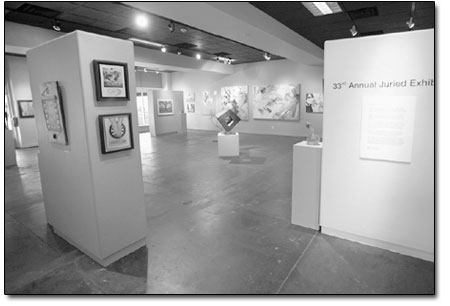|
|
||
|
Veering from tradition
by Jules Masterjohn his year’s 33rd annual Juried Exhibition, sponsored by the Durango Arts Center, is a departure of sorts from juried shows in the past. The differences can’t be seen so much in the type or quality of works selected: the gallery is still filled with accomplished pieces representing abstract through realistic styles created in various media. The can be found in the new technology used by artists to submit their works for selection. This year, the DAC has gone 21st century. Artists entered the annual competition via a web-based application process whereby they submitted digital photographs of their artwork and paid entry fees online. Gone – at least for this exhibit – are the days when artists brought their work into the gallery for judging and picked up the nonselected work the next day. Some may feel that the new process is a loss to local artists’ sense of community while others have appreciated the nudge into the state-of–the-art application process. The online technology enabled artists from all over the country to enter the exhibit, not only, as in the past years, those who live within driving distance. If this national “call to artists” didn’t tip over some local artists’ paint pots, the fact that the solo juror, Santa Fe educator and artist Shelley Horton-Tripp, selected works that she liked as her criteria, may have been cause for upset by some. There are very few landscapes included and many new names. Local politics aside, Horton-Tripp selected fresh and interesting works. However, as in past shows, the experience is compromised by too much art hanging too close together. In her juror’s statement, posted prominently at the entrance to the Barbara Conrad Gallery, Horton-Tripp makes her perspective as the juror perfectly clear. “When I look at art, I judge it by whether or not the hairs on my arm stand up. This physicality is a response to color, shape, composition and all the other formal aspects. But, the personal measure is whether or not the artwork feels like an honest response to our world. In our commitment as artists, we need to transcend/transmute this thing we call reality as much as define it.” She continues to state that the overriding thematic of the artwork chosen for the is a “macrocosm/microcosm approach” to this examination.It’s not surprising that Durango artist Gary McVean had all three of his near-psychedelic paintings selected, and his “Close Up #40,” was chosen by Horton-Trippe to receive the “Best of Show” award. His work explores the intersection between the grandest and minutest of matter in the universe. McVean creates acrylic paintings that are comprised of small, multicolored, circular units that describe what might be interpreted as magnified bits from nature, perhaps cells dividing or depictions of microbial organisms. Over the last many years, McVean has become increasingly aware of the shared visual qualities of the macrocosmic and microcosmic worlds. “Looking at pictures from Hubble (telescope), I see that everything is made up of particles just like atoms. It’s hard for me to get away from it.” Taking his lessons from the Impressionists, McVean fur ther animates his work by using a complementary color scheme of orange and blue. The resulting optics cause his images appear to vibrate.“If you look at my stuff, it looks kind of alive,” he offered by telephone. Not only inspired by the conceptual intersection between cosmic and molecular structures, McVean also draws from what his mind sees just before falling asleep. “My brain fires in colors ... I’ve ripped that off quite a few times for my paintings.” Other works that seem to jump off the wall are oil paintings by Durango artist Bradley Kachnowicz. His “Desert Solitaire” embraces color theory by presenting a blazingly hot orange background with images in cool blues used to depict a roadrunner and a pair of hands dealing cards. The paint is loosely applied in an intuitive manner where the brush strokes (or finger marks?) create an activated and tactile surface. Painting dominates the show and there are many intriguing 2-D works presented. Farmington artist Debra Blair’s encaustic (bees wax and pigment) painting smells great and seduces one’s eye quietly, as do the surrealistic mixed-media works by John Cross, who combines a photographic process on aluminum with oil-painted imagery. Durango artist Barbara Heinrich continues her Pop Art-inspired shoe fetish with her painting, “Red Converse.” Photography is represented by a small number of regionally known artists such as Linda Pampinella, Heather Leavitt and Chet Anderson. Sculptural works are relatively few in comparison to the wall works. Notable for its intricate texture and luminous physicality is the cast-glass arm, “Sometimes This Happens,” by Mary Jo Bayliss. Jenny Treanor received the Juror’s Choice award for her found-object assemblage, “Loose Change,” a whimsical arrangement of an antique hand drill, a leather purse, and an iron stand. The multiple meanings of the title and the elegance with which she has combined the objects as well as the compatibility of their surface qualities and color, makes this a memorable piece. • The 33rd Annual Juried Exhibition is on display at the Durango Arts Center, 802 E. Second Ave., through June 27. Gallery hours are Tuesday –Saturday, 10 a.m. – 5 p.m. The Salon de Refuse, works that were not selected for the Juried Exhibition, is on display across the street at Steamworks Brewing.
|
In this week's issue...
- May 15, 2025
- End of the trail
Despite tariff pause, Colorado bike company can’t hang on through supply chain chaos
- May 8, 2025
- Shared pain
Dismal trend highlights need to cut usage in Upper Basin, too
- April 24, 2025
- A tale of two bills
Nuclear gets all the hype, but optimizing infrastructure will have bigger impact


